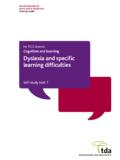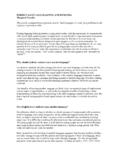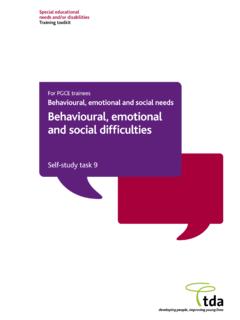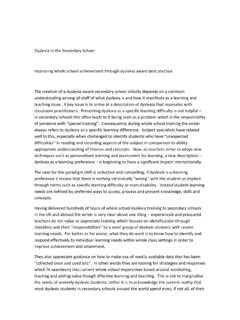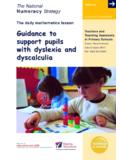Transcription of The Phonics Screening Check – Responding to …
1 The Phonics Screening Check Responding to ResultsAdvice for schools supporting the learner with dyslexia -SpLDPage 2 of 16 Wave 3 Additional highly personalisedinterventionsWave 2 Additional interventions toenable children to work at agerelated expectations or aboveWave 1 Inclusive quality first teaching for allThe Three Waves of ProvisionThis booklet is for the teacher who is worried about the progress pupils are making in literacy. The advice in this booklet follows the Three Waves of Intervention model. As a rough guide:Wave 1 Intervention can be seen as classroom-based 2 Intervention can be seen as school-based 3 Intervention can be seen as external specialised 3 of 16 Contents 5 What is dyslexia ? 5 Advice on administration of the Phonics Screening Check for the learner with dyslexia -SpLD 6-9 Interpreting results : Studying the results for the individual child 9-10 Three Waves of Intervention 11 Teacher Continuing Professional Development 12 Appendix 1: Research to support choice of Interventions 13 Appendix 2: Questions designed to support a whole-school approach to literacy provision 14-15 Appendix 3: Case StudiesPage 4 of 16 How this booklet links to the DfE s document called The Phonics Screening Check - Responding to the results : Departmental advice for Reception and Year 1 teachers This useful guide is aimed primarily at Wave 1 intervention.
2 Pages eight to eleven offer guidelines for recognising pupils who may require Wave 2 and Wave 3 interventions. It is this section that is supplemented by The dyslexia -SpLD Trust this booklet links to The Communications Trust s document Communicating Phonics Children with speech, language and communication difficulties will require Quality First teaching (Wave 1) and may or may not require Wave 2 and 3 interventions. Communicating Phonics offers a table, on page 9, for interpreting general response. This is a useful first step for a teacher wishing to identify the type of difficulty a pupil may be having. This is followed by a comprehensive list of different speech, language and communication difficulties, including examples of specific error-types for each that might be highlighted by the Phonics Screening 5 of 16 What is dyslexia ?
3 Definition of dyslexiaDyslexia is a learning difficulty that primarily affects the skills involved in accurate and fluent word reading and spelling. Characteristic features of dyslexia are difficulties in phonological awareness, verbal memory and verbal processing speed. dyslexia occurs across the range of intellectual abilities. It is best thought of as a continuum, not a distinct category, and there are no clear cut-off points. Co-occurring difficulties may be seen in aspects of language, motor co-ordination, mental calculation, concentration and personal organisation, but these are not, by themselves, markers of dyslexia . A good indication of the severity and persistence of dyslexic difficulties can be gained by examining how the individual responds or has responded to well founded intervention.
4 (p31, The Rose Report 2009) Advice on administration of the Phonics Screening Check for the learner with dyslexia -SpLD The booklets from which the Check is administered can be reprinted onto coloured paper (see the DfE section on access arrangements). There is also some flexibility on how the instructions are given (see The Check Administrator s Guide , downloadable from the National Curriculum Assessment website. For children who have difficulties following instructions, particularly when hearing them for the first time, teachers can practice the process in advance. To do this, similar real words and non-words can be printed onto sheets and the child allowed to practice the activity before the formal test itself. Samples of the words are available from the Department s may be useful, too, to practice the shift between real and non-words.)
5 In the Check , the non-words are placed next to a picture of an imaginary animal to remind the child not to seek for a real word. The child is to decipher the imaginary name of the imaginary animal. It is possible that some children may need to practice this , during the Check , real and non-words are presented in blocks of four, moving between real and non-words throughout the test. This may be difficult for some children. For example, blow as a real word would be scored incorrectly if pronounced to rhyme with cow . However, in the non-words, ow could be pronounced correctly to rhyme with either cow or blow . For some children, for whom reading takes much concentration, the shift from real to non-word and back again could induce errors not normally 6 of 16 Interpreting resultsStudying the results for the individual child:On the marking sheet, identifying correct or incorrect is mandatory, but there is also space provided to identify what type of error is being made by the child.
6 A selection of types of error is illustrated in this video from the DfE website, which is accompanied by a transcript for further information. Each error is described verbally as an aid to further One example is of a child being presented with the non-word yed which is then read as if to rhyme with raid . This indicates that the child is correctly reading both the beginning and ending consonants, but is misreading the middle vowel sound. The teacher can analyse the errors made by the child and look for recurring error patterns. If the child s responses were not recorded in enough detail, the test could be re-administered by the teacher to obtain further information, or a similar process using real and nonsense words undertaken to allow further investigation into error the analysis of error patterns suggest a direction for further support?
7 Examples might include further work on: Specific phoneme-grapheme correspondences, such as ea or the split digraph (magic e ) Reinforcement of sound/symbol correspondence (Rose review encourages teachers to do this in a playful way ) Work on alliteration, onset and rime Greater exposure to rhyme and other explicit analytic Phonics (spelling groups such as those ending in ight) Linking syllables to an out-breath in multisensory teaching as a precursor to understanding the role of vowels (often also seen in spelling errors with missing vowels such as hlcoptr for helicopter ) After this process, the teacher may want to consider the following questions:Are the results surprising?Surprising results suggest one of two conclusions, depending on the answers to the further questions below.
8 1) The child tested very badly on the day. Error patterns displayed during the Check are very rarely present on other occasions, either for real or non-words. It is likely that no further action is ) Some existing difficulties with processing grapheme-phoneme correspondence have come to light as a result of the test, meriting further exploration by the does the result compare to: previous reading assessments; other records of progress and overall attainment levels?The Check results may provide an insight into the child s previous assessment 7 of 16 Did the teacher have previous concerns about this child?The child may have been displaying other examples of difficulty in the classroom, not related to their reading or literacy levels. Typical examples might be: Poor attention span Poor behaviour Difficulty getting ideas down on paper Difficulty following instructions Poor memory Disorganisation Clumsiness Untidy presentation of work Untidy handwriting Low self esteem Low motivation Low attainment in MathsIt may be possible to build up a more complete picture of the child s strengths and weaknesses and plan for further interventions, at Wave 1 and Wave 2 level (see below).
9 Considering further investigation into a child s learning needsIf you have taken a thorough, systematic approach to Phonics teaching and an individual in your cohort has not met the standard of the Check , it may be there is an underlying special educational need which needs addressing before that child can progress beyond decoding towards reading fluently. Questions to ask when considering the outcome for a child who has not attained the standardIs this the outcome I would expect for this particular child? If not, what are the possible reasons for this level of performance on the day? Were there specific home circumstances; challenging conditions in the area where Check was carried out; if the child is a hearing impaired child, have they had a recent change in hearing aids; were there temporary hearing problems as in glue ear ; perhaps an unidentified sight problem?
10 Does the outcome from the Check indicate: very limited knowledge of Phonics ? progress in Phonics knowledge, albeit at a much slower pace than the majority of peer group? a pattern of errors that suggest a specific area of difficulty? Are the child s phonological awareness skills established? (For example, sound discrimination; rhyme and rhythm, alliteration; oral blending and segmenting or low confidence /automaticity in these areas).What is known about their progress in other areas of reading? (For example: ability to learn tricky or phonically irregular words; concepts of print; enjoyment of reading and stories; comprehension of stories; ability to read aloud).Are the child s speech, language and communication levels at age-appropriate levels?

